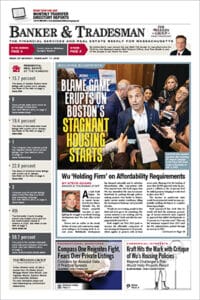
Rick Dimino
Metropolitan Boston’s transportation challenges requires a two-track approach. Today, commuters are concerned about safety, reliability and affordability issues at the MBTA. These factors are top of mind during the current return to the workplace and will continue to be relevant in the months ahead. Longer-term, the success of the region’s economy, transit orientated development and carbon emissions-reduction plans all relate to the capacity of the MBTA.
Addressing both current and future transit needs is not easy, but recent years saw meaningful progress in both areas. This momentum is now slowing, as important transit plans are falling aside and public commitments are falling off-track.
Gov. Charlie Baker created a five-person Fiscal and Management Control Board (FMCB) to oversee the MBTA after the system’s failure during the winter of 2015. Over six years this group established new priorities related to safety repairs, decarbonization, equity and new infrastructure necessary to rebuild the T. They helped to deliver the Green Line Extension project, managed the transition to new Orange and Red Line vehicles and mapped out a path for the future overhaul of the entire commuter rail network. Today, the MBTA service plans and bureaucracy are both stronger because of this effort.
This past fall, Governor Baker and the legislature transitioned to a new board of directors. This group is now responsible for overseeing the transit agency’s new challenges, but they are heading in new direction in both style and philosophy. In many ways, this current board is stepping back from some public commitments that addressed equity issues for riders and unlocked the commuter rail system’s future potential. Both changes are discouraging.
Better Trains Critical for New Housing
Last summer, the FMCB voted to create a means-tested fare program that would have begun in September 2023. By offering lower fares to riders with limited means, the MBTA aimed to encourage the use of mass transit and support economic mobility. Boston Mayor Michelle Wu successfully expanded free-bus service on three MBTA bus routes, but a systemwide approach is necessary to serve riders from outside of Boston, too. Despite this FMCB promise, the new board has said it will not carry forward on this promise.
With the commuter rail, after years of study through the official Regional Rail Vision, the FMCB voted in 2019 to “transform the current commuter rail line into a significantly more productive, equitable and decarbonized enterprise.” This modern system can be possible through investments to electrify the system and purchase new vehicles. Riders would see more frequent service schedules so that the commuter rails could operate more like the MBTA’s subway services. A regional rail system is an effective way to help address traffic congestion, reduce carbon emissions and help to better connect growing business districts and Gateway Cities.
Real solutions were identified in partnership with riders, community leaders and the business community.
Massachusetts’ housing affordability crisis is another compelling reason to invest in commuter rail. The recently enacted law requiring multifamily housing zones in every community served by the MBTA could result in over 300,000 additional housing units located near transit stations, according to an estimate by the Metropolitan Area Planning Council. The MBTA must uphold the transit component in “transit orientated development,” otherwise the future workforce throughout eastern Massachusetts will face increased roadway traffic that will overwhelm our roads and depress the economy.
Business Leaders, Riders Have Spoken
Unfortunately, the current MBTA capital investment plan is not consistent with the blueprints and schedules necessary to advance toward a regional rail system. The FMCB called for a phased approach to transforming the commuter rail, starting with the purchase of new electric train sets and electrification of the Fairmount, Providence and Newbury/Rockport lines. The current MBTA budget is silent on these ideas. While the investment plans do support the FMCB’s commitments on new vehicles for the Green Line and initial design plans for the Red-Blue Connector, its lack of support for an improved commuter rail system is a major setback to the region.
The future success of the MBTA requires a sustained commitment on new infrastructure projects that will cross multiple governors’ time in office. While it is the prerogative of the MBTA Board of Directors to develop its own governance style and strategic priorities, what should not change is the focus on the people who deserve high-quality transit service. Real solutions were identified in the FMCB’s strategic planning process. These studies and data were developed in partnership with riders, community leaders and the business community, and they should find support under any board and governor.
We all know that the commonwealth must transition away from diesel trains and towards an electrified transit system. Major investments in resiliency infrastructure are necessary to protect the existing subway tunnels and power system so that system can withstand growing climate impacts and sea level rise. Also, it is justified to offer means-tested fares to many riders throughout the region who rely on public transit.
It is not time to start over or pull back from the solutions identified by the FMCB. We simply need to stay on track with the established plans to improve the MBTA today and for tomorrow.
Rick Dimino is CEO of A Better City.





